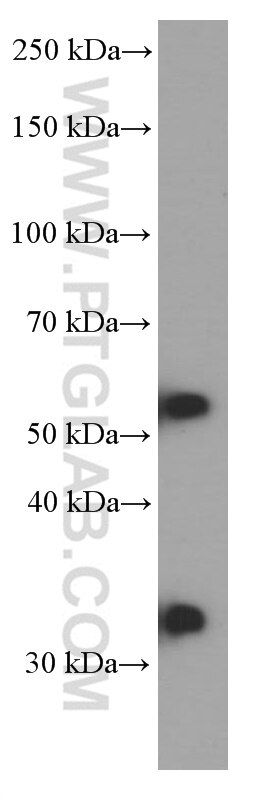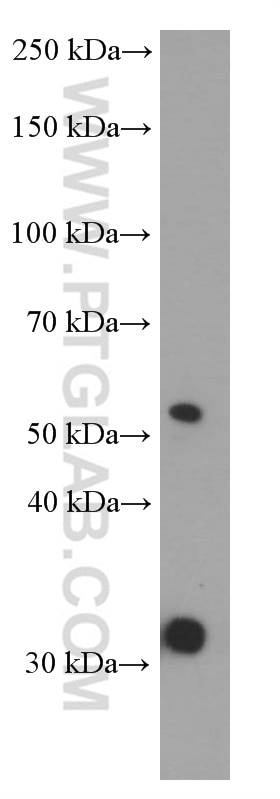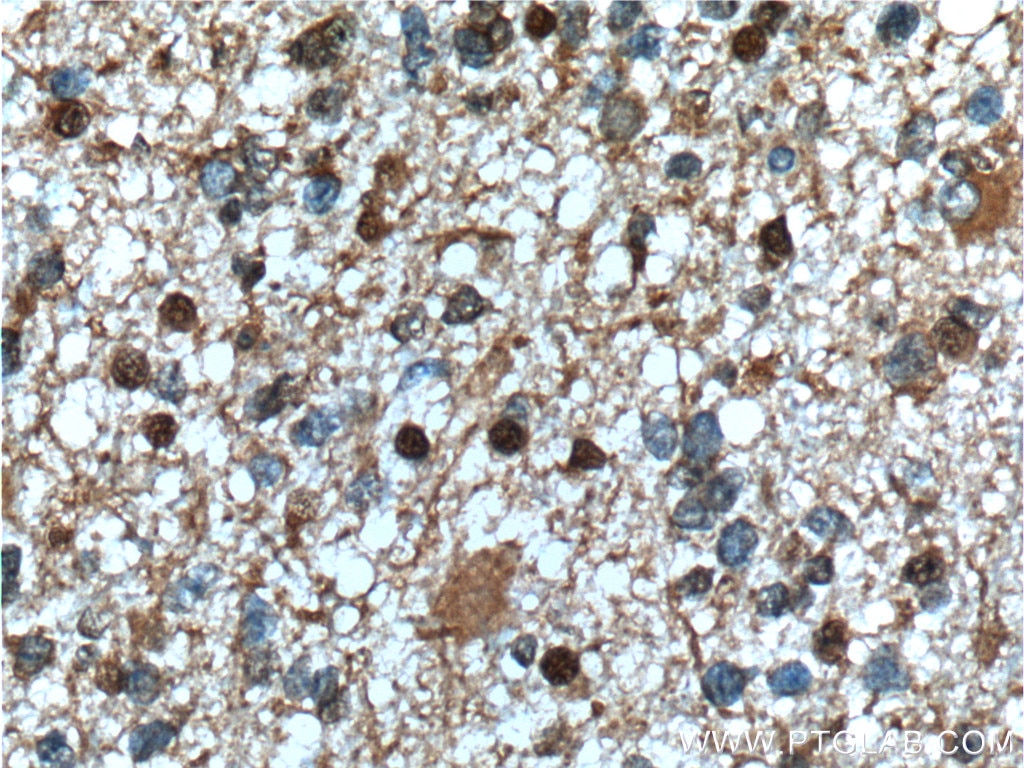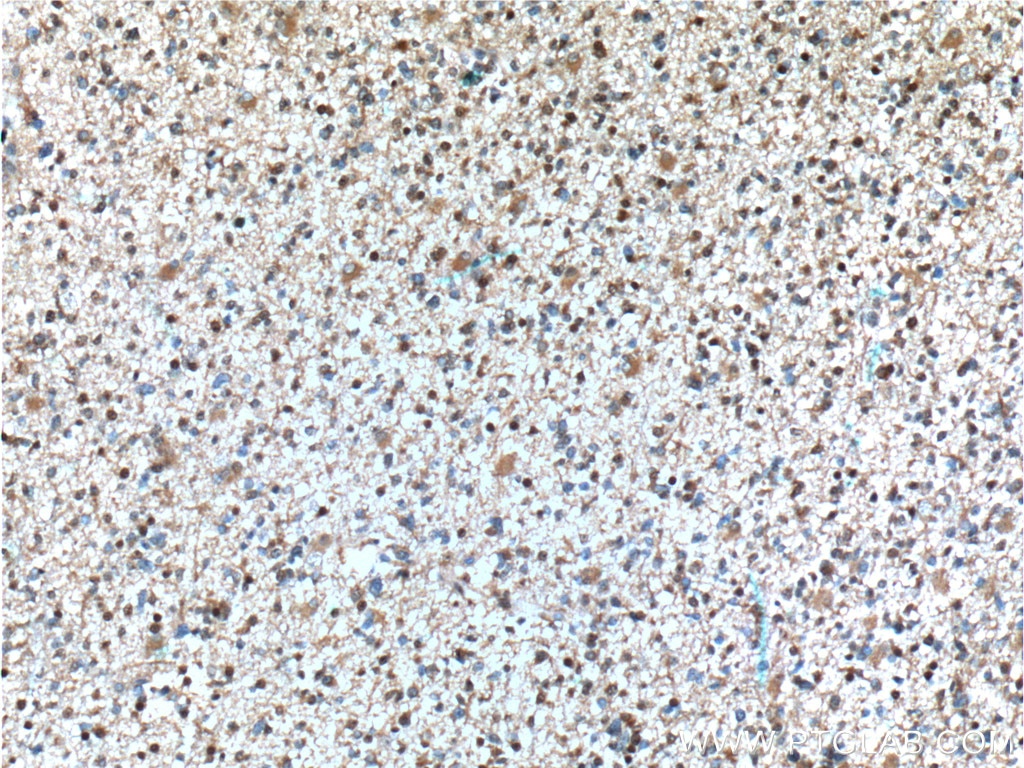Anticorps Monoclonal anti-PHF10
PHF10 Monoclonal Antibody for IHC, WB,ELISA
Hôte / Isotype
Mouse / IgG1
Réactivité testée
Humain, souris
Applications
WB, IHC, IF, CoIP, ELISA
Conjugaison
Non conjugué
CloneNo.
4D4C6
N° de cat : 66341-1-Ig
Synonymes
Galerie de données de validation
Applications testées
| Résultats positifs en WB | tissu cérébral humain fœtal, cellules HEK-293, cellules Neuro-2a |
| Résultats positifs en IHC | tissu de gliome humain il est suggéré de démasquer l'antigène avec un tampon de TE buffer pH 9.0; (*) À défaut, 'le démasquage de l'antigène peut être 'effectué avec un tampon citrate pH 6,0. |
Dilution recommandée
| Application | Dilution |
|---|---|
| Western Blot (WB) | WB : 1:500-1:2000 |
| Immunohistochimie (IHC) | IHC : 1:50-1:500 |
| It is recommended that this reagent should be titrated in each testing system to obtain optimal results. | |
| Sample-dependent, check data in validation data gallery | |
Applications publiées
| WB | See 1 publications below |
| IF | See 1 publications below |
| CoIP | See 1 publications below |
Informations sur le produit
66341-1-Ig cible PHF10 dans les applications de WB, IHC, IF, CoIP, ELISA et montre une réactivité avec des échantillons Humain, souris
| Réactivité | Humain, souris |
| Réactivité citée | Humain, souris |
| Hôte / Isotype | Mouse / IgG1 |
| Clonalité | Monoclonal |
| Type | Anticorps |
| Immunogène | PHF10 Protéine recombinante Ag19096 |
| Nom complet | PHD finger protein 10 |
| Masse moléculaire calculée | 408 aa, 46 kDa |
| Poids moléculaire observé | 56 kDa, 35 kDa |
| Numéro d’acquisition GenBank | BC020954 |
| Symbole du gène | PHF10 |
| Identification du gène (NCBI) | 55274 |
| Conjugaison | Non conjugué |
| Forme | Liquide |
| Méthode de purification | Purification par protéine G |
| Tampon de stockage | PBS avec azoture de sodium à 0,02 % et glycérol à 50 % pH 7,3 |
| Conditions de stockage | Stocker à -20°C. Stable pendant un an après l'expédition. L'aliquotage n'est pas nécessaire pour le stockage à -20oC Les 20ul contiennent 0,1% de BSA. |
Informations générales
PHF10, also named as BRG1-associated factor 45a, is a 498 amino acid protein, which locate in the nucleus and Belongs to the SAYP family. PHF10 Involve in transcription activity regulation by chromatin remodeling. It Belongs to the neural progenitors-specific chromatin remodeling complex (npBAF complex) and is required for the proliferation of neural progenitors. During neural development a switch from a stem/progenitor to a post-mitotic chromatin remodeling mechanism occurs as neurons exit the cell cycle and become committed to their adult state. The transition from proliferating neural stem/progenitor cells to post-mitotic neurons requires a switch in subunit composition of the npBAF and nBAF complexes. As neural progenitors exit mitosis and differentiate into neurons, npBAF complexes which contain ACTL6A/BAF53A and PHF10/BAF45A, are exchanged for homologous alternative ACTL6B/BAF53B and DPF1/BAF45B or DPF3/BAF45C subunits in neuron-specific complexes (nBAF). The npBAF complex is essential for the self-renewal/proliferative capacity of the multipotent neural stem cells. The nBAF complex along with CREST plays a role regulating the activity of genes essential for dendrite growth. PHF10 exists as several isoform and the calculated molecular weight of each isoform is 42 kDa, 37 kDa, 51 kDa, and 56 kDa.
Protocole
| Product Specific Protocols | |
|---|---|
| WB protocol for PHF10 antibody 66341-1-Ig | Download protocol |
| IHC protocol for PHF10 antibody 66341-1-Ig | Download protocol |
| Standard Protocols | |
|---|---|
| Click here to view our Standard Protocols |
Publications
| Species | Application | Title |
|---|---|---|
Glia DHHC5 facilitates oligodendrocyte development by palmitoylating and activating STAT3. | ||
bioRxiv BRD9-SMAD2/3 orchestrates stemness and tumorigenesis in pancreatic ductal adenocarcinoma | ||
Gastroenterology BRD9-SMAD2/3 orchestrates stemness and tumorigenesis in pancreatic ductal adenocarcinoma |







